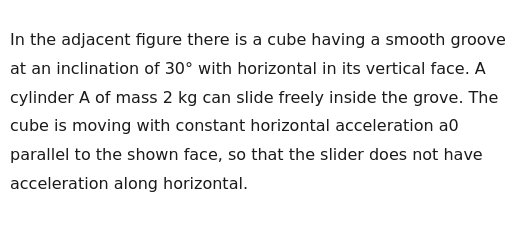Question
Question: In the adjacent figure there is a cube having a smooth groove at an inclination of 30° with horizont...
In the adjacent figure there is a cube having a smooth groove at an inclination of 30° with horizontal in its vertical face. A cylinder A of mass 2 kg can slide freely inside the grove. The cube is moving with constant horizontal acceleration a0 parallel to the shown face, so that the slider does not have acceleration along horizontal.

g√3
Solution
Let the horizontal acceleration of the cube be a0=a0x^, where the x-axis is horizontal and the z-axis is vertical upwards. The groove is in a vertical face (say, the x-z plane) and is inclined at 30° with the horizontal. The direction along the groove can be represented by the unit vector u^=cos(30∘)x^+sin(30∘)z^.
Let acyl,I be the acceleration of the cylinder in the inertial frame, and acyl,cube be the acceleration of the cylinder relative to the cube. The acceleration of the cube in the inertial frame is acube,I=a0x^. The relation between these accelerations is acyl,I=acube,I+acyl,cube.
The problem states that the slider does not have acceleration along the horizontal direction in the inertial frame. This means the horizontal component of acyl,I is zero. acyl,I⋅x^=0. (acube,I+acyl,cube)⋅x^=0. (a0x^+acyl,cube)⋅x^=0. a0+acyl,cube⋅x^=0.
Since the cylinder is constrained to move along the groove, its acceleration relative to the cube must be along the groove. Let acyl,cube=arelu^, where arel is the magnitude of the acceleration along the groove. acyl,cube=arel(cos(30∘)x^+sin(30∘)z^).
Substitute this into the horizontal acceleration condition: a0+(arel(cos(30∘)x^+sin(30∘)z^))⋅x^=0. a0+arelcos(30∘)=0. a0+arel(3/2)=0. arel=−2a0/3.
Now consider the forces acting on the cylinder in the non-inertial frame of the cube. The forces are:
- Gravity: G=−mgz^.
- Pseudo force: Fp=−ma0=−ma0x^.
- Normal force from the groove: N. Since the groove is smooth, the normal force is perpendicular to the direction of the groove u^.
According to Newton's second law in the non-inertial frame: G+Fp+N=macyl,cube=marelu^.
To find arel, we can project the forces equation onto the direction of the groove u^. Since N is perpendicular to u^, N⋅u^=0. (G+Fp+N)⋅u^=(marelu^)⋅u^. (G+Fp)⋅u^=marel(u^⋅u^)=marel.
Substitute the force vectors and u^: (−mgz^−ma0x^)⋅(cos(30∘)x^+sin(30∘)z^)=marel. −ma0cos(30∘)−mgsin(30∘)=marel. Divide by mass m: −a0cos(30∘)−gsin(30∘)=arel. −a0(3/2)−g(1/2)=arel.
We now have two expressions for arel:
- arel=−2a0/3
- arel=−a0(3/2)−g(1/2)
Equating the two expressions: −2a0/3=−a0(3/2)−g(1/2). Multiply the entire equation by 23 to clear the denominators: (−2a0/3)×23=(−a03/2)×23−(g/2)×23. −4a0=−a0(3×3)−g3. −4a0=−3a0−g3. Rearrange the terms to solve for a0: −4a0+3a0=−g3. −a0=−g3. a0=g3.
Using the approximate value g≈10m/s2 and 3≈1.732: a0≈10×1.732=17.32m/s2.
The mass of the cylinder (2 kg) is not needed for the calculation of a0.
The final answer is g3.
Explanation:
- Set up coordinate system: x-horizontal, z-vertical. Assume cube acceleration a0=a0x^.
- Define groove direction u^=cos(30∘)x^+sin(30∘)z^.
- Use relative motion equation acyl,I=acube,I+acyl,cube.
- Apply the condition acyl,I⋅x^=0 and acyl,cube=arelu^ to find arel in terms of a0: a0+arelcos(30∘)=0⟹arel=−a0/cos(30∘)=−2a0/3.
- Analyze forces in the cube's non-inertial frame: G=−mgz^, Fp=−ma0x^, N.
- Apply Newton's second law in the cube frame projected onto the groove direction: (G+Fp)⋅u^=marel.
- Calculate the projection: (−mgz^−ma0x^)⋅(cos(30∘)x^+sin(30∘)z^)=marel⟹−ma0cos(30∘)−mgsin(30∘)=marel.
- Simplify to get arel in terms of a0 and g: arel=−a0cos(30∘)−gsin(30∘)=−a0(3/2)−g(1/2).
- Equate the two expressions for arel and solve for a0: −2a0/3=−a0(3/2)−g(1/2)⟹a0=g3.
